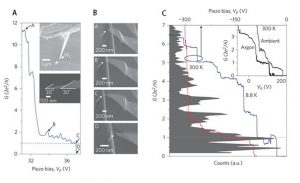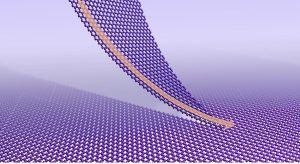Current on the edge: IISc discovers a new electrical conductor
We have been able to experimentally access, for the first time, a new type of electrical conductor which was theoretically predicted nearly 20 years ago to exist at the edge of graphene, the planar hexagonal lattice of carbon atoms. The unique property these “edge states” is that they allow the flow of charge without impedance, even at room temperature and above. These states arise due to the zigzag manner in which the carbon atoms are placed at the edge of graphene. Many groups over the world have been trying to access these edges since the emergence of graphene in 2004. They have remained unsuccessful because when current flows through graphene, it flows through both the edge as well as the bulk. We succeeded in this endeavour by keeping our graphene edges very clean and narrowing down the width of graphene to less than ten nanometers. The bulk then becomes highly resistive and the current flows through the edge alone. We believe that this successful demonstration of the dissipationless edge conduction will act as a great incentive to develop new chemical methods to make high-quality graphene nanoribbons or nanostrips with clean edges, which can lead to realising power-efficient electronics and to quantum information transfer, even at room temperature.
Reference:
Amogh Kinikar, T. Phanindra Sai, Semonti Bhattacharyya, Adhip Agarwala, Tathagata Biswas, Sanjoy K. Sarker, H. R. Krishnamurthy, Manish Jain, Vijay B. Shenoy, and Arindam Ghosh. “Quantized edge modes in atomic-scale point contacts in graphene.” Nature Nanotechnology (2017).
Website: www.physics.iisc.ernet.in/~arindam

Caption: A, Evolution of the electrical conductance of an exfoliated flake during the exfoliation process. B, SEM images showing the structural state of the exfoliate at the conductances identified as (A-D) in the trace shown in A. C, Conductance histogram and representative traces for evolution of electrical conductance during exfoliations in high vacuum (10−6 mbar) at room temperature and 8.8 K. Inset: typical exfoliations under ambient conditions and argon atmosphere, showing very little or no signature of molecular contamination of the edges.

Caption: Tearing graphene to produce a perfect boundary. The channel through which the electrons can pass through without scattering lies only on the zigzag edge of the tear (Indicated by the arrow)

Caption: Some of the members of the team: (from left to right) Arindam Ghosh, H.R. Krishnamurthy, Manish Jain, Amogh Kinikar, T. Phanindra Sai, Vijay Shenoy and Adhip Agarwala.
Other Featured research






